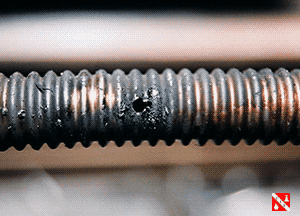
Since the 1990s, a product called corrugated stainless steel tubing (CSST) has been used in some home and light commercial construction. CSST is used to deliver fuel gases to gas appliances such as furnaces, water heaters and stoves – a function previously done using rigid black iron pipe. Since CSST is sold on a continuous roll and does not require the labor-intensive cutting and splicing that black iron pipe does, it is more practical, easy and cost-effective to install. According to general contractors, the savings per home can often be as much as $2,000 to use CSST, which led many contractors to choose it over the traditional black iron pipe.
Over a decade ago and not too many years after CSST entered the marketplace, forensic fire investigators started to see fires that resulted when lightning struck a building and a failure of the CSST occurred. The electrical energy from the lightning charged the CSST, and if the CSST was in close proximity to another metal object with a different grounding potential, such as a water pipe or HVAC ductwork, an electrical arc occurred that often melted holes in the thin wall of the CSST. Fuel gas then escaped and was ignited by the electrical arc, resulting in an unintended fire. Since CSST is often installed in walls, below floors and in attic spaces, the fires generally would burn unnoticed until other building components ignited and a much larger fire resulted.
Despite lightning’s categorization as “Act of God,” many successful liability claims have been made against CSST manufacturers and construction contractors who would not always install CSST in a manner compliant with a manufacturer’s installation instructions. The influx of liability claims and the concern for safety caused some CSST manufactures to re-engineer their products and one to discontinue the sale of CSST in its original design completely. Other manufacturers have stopped short of doing the same but have greatly expanded their installation instructions beyond what was initially provided. Nonetheless, CSST is still being used and has been installed in millions of homes in the United States. Many of these homes will never experience a CSST-related fire, but some may, and that could happen soon after construction or many years in the future.

CSST is sold in different sizes depending on the consumption need. CSST in most homes is about the same diameter as an ordinary garden hose and is either wrapped in a yellow plastic material, or in newer designs, a black plastic. CSST is not the same as a similar-looking, shorter (3-5 foot) connection tube, commonly called a “pigtail,” that connects an appliance to a wall connection port or to black iron pipe. CSST may or may not be visible to the homeowner; however, as one step in risk reduction, concerned homeowners can look for it in their homes and simply make sure it is not in contact with any other metals.
For additional information about CSST and lightning-caused fires, contact any of Unified Investigations & Sciences’ offices nationwide. We have experts with specialized knowledge in these areas who are ready and willing to assist you.
Michael Reynolds, IAAI-CFI, FCLS, National Corporate Audit Services Manager
Unified Investigations & Sciences | a Sedgwick company